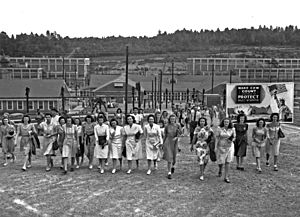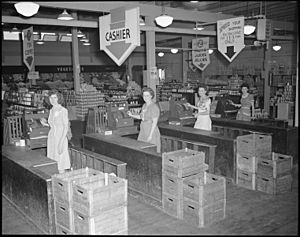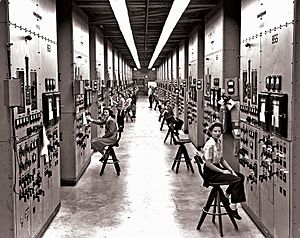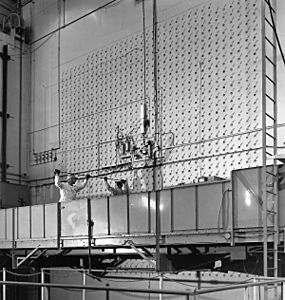Ed Westcott facts for kids
Quick facts for kids
Ed Westcott
|
|
|---|---|
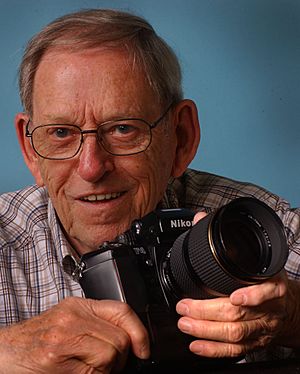
Westcott in 2004
|
|
| Born |
James Edward Westcott
January 20, 1922 Chattanooga, Tennessee, U.S.
|
| Died | March 29, 2019 (aged 97) Oak Ridge, Tennessee, U.S.
|
| Nationality | American |
| Occupation | Photographer |
| Known for | Manhattan Project photography |
James Edward Westcott (January 20, 1922 – March 29, 2019) was an American photographer. He became famous for his work with the United States government in Oak Ridge, Tennessee. He took pictures during the top-secret Manhattan Project and the Cold War.
Ed Westcott was one of the very few people allowed to have a camera in Oak Ridge during the Manhattan Project. This meant he created almost all the pictures we have today of the secret city. His photos show how the huge production facilities were built and operated. They also show what everyday life was like for people living in the hidden community of Oak Ridge.
Contents
How Ed Westcott Started Photography
Early Life and First Camera
Ed Westcott was born on January 20, 1922, in Chattanooga, Tennessee. His family later moved to Nashville. When Ed showed interest in photography, his dad saved up for a whole year. He bought Ed a Foth Derby camera for $25. This gift in 1934, during the Great Depression, set young Ed on his future path. As a teenager, he developed photos for friends and worked in several photo studios in Nashville.
Working for the Army
In 1941, Ed joined the U.S. Army Corps of Engineers as a photographer. His job was to take pictures of different places. He photographed dams, a prisoner-of-war camp, and facilities at Fort Campbell near the Tennessee–Kentucky border.
The Secret City Photographer
Joining the Manhattan Project
In December 1942, when Ed was 20, the Army sent him to the Clinton Engineer Works. This was the secret Oak Ridge site. Ed Westcott was the 29th person hired for the Manhattan Project in Oak Ridge. He worked there as an official government photographer from 1942 to 1966.
During much of World War II, he worked for a company under contract to the Army. He photographed the building and inner workings of huge facilities like the X-10, K-25, Y-12, and S-50. These places were crucial for the secret project. He also took pictures of daily life in Oak Ridge for the local newspaper, the Oak Ridge Journal. For his wartime photos, Westcott used large cameras like the Speed Graphic or an 8×10 Deardorff view camera.
Revealing the Secret
Some of Ed's photos were among the first pictures shared with the news media. This happened when the world learned about the first atomic bomb and the secret project that created it. Before the bombings of Hiroshima and Nagasaki in August 1945, 18 of his photos were secretly printed. They were ready for the big announcement. These pictures were then made public and given to the press. Ed also developed film taken by teams assessing the damage after the bombings. It took three days to print these photos, and armed guards protected his darkroom.
After the War
In June 1945, Westcott became an Army employee again. After the war, he started working for the U.S. Atomic Energy Commission (AEC) in 1946. In 1966, he moved to the AEC headquarters near Washington, D.C.. He continued to work for the AEC and its later agencies until he retired in 1977. During this time, he photographed nuclear power stations all across the United States.
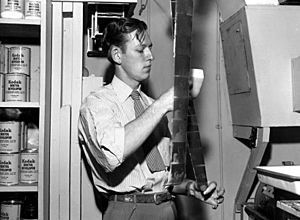
Over his 35-year career, Ed Westcott photographed many important people. These included Manhattan Project scientists like J. Robert Oppenheimer and Glenn Seaborg. He also photographed U.S. Army Generals, an Admiral, a Secretary of War, and several U.S. Presidents.
The Famous Oppenheimer Photo
One of Westcott's most famous photos is a portrait of J. Robert Oppenheimer from February 1946. This picture shows the scientific director of the Manhattan Project looking tired from his huge responsibilities. When Westcott met Oppenheimer, the scientist wanted a cigarette but didn't have any change. Westcott gave him some money. Oppenheimer bought his cigarettes, lit one, and then Westcott took the picture. It shows Oppenheimer sitting by a fireplace mantel in the Oak Ridge Guest House, holding the lit cigarette.
A photography professor, Baldwin Lee, noted that this photo was carefully planned. Westcott told Oppenheimer to sit "slightly askance" and lean forward a bit. Westcott took the picture from a low angle, making the viewer look up at Oppenheimer. This made the scientist seem even more important. The professor also pointed out that Oppenheimer's gaze in the photo seems to be looking at "something very distant and something only he can see."
Exhibitions and Books
Many of Ed Westcott's photographs were once secret. Some remained classified for many years. But now, most of his work can be seen by everyone. About 5,000 of his negatives are kept safe by the National Archives in Washington, D.C. His photos have been used widely in books and exhibits about the Manhattan Project. Often, his name wasn't even mentioned as the photographer.
The first museum show just for Westcott's work was in 1981 at the Children's Museum of Oak Ridge. It was called "Oak Ridge Seen 1943–1947: 20 Photographs by Edward Westcott." In 2005, the Ewing Gallery of Art and Architecture at the University of Tennessee had an exhibit called "Through the Lens of Ed Westcott: A Photographic History of World War II's Secret City." Both the American Museum of Science and Energy and the Children's Museum of Oak Ridge have exhibits about Westcott and his work. They also show his photos as part of displays on Oak Ridge's history. Some photos from the Ewing Gallery exhibit now travel to other museums.
One of Westcott's photos from 1945, showing an Oak Ridge supermarket, was featured by the National Archives in a 2005–2006 exhibit. Collections of his Oak Ridge photos have been published in a catalog for the Ewing Gallery exhibit and in a book called Oak Ridge by Ed Westcott. A huge photo by Westcott, showing a shift change at Y-12 during the Manhattan Project, is displayed on a cafeteria wall at the Y-12 National Nuclear Security Complex. It's 20 feet by 50 feet!
Personal Life
Ed Westcott lived in Oak Ridge for many years. He was married to Esther Seigenthaler Westcott for 56 years before she passed away. They had five children. His grandson, Phil, is also a photographer. He works in Alaska for the National Park Service, documenting the effects of global warming. In 2005, Westcott had a stroke that affected his speech. A shopping center in Oak Ridge, which opened in 2014, is named the "Westcott Center" in his honor.
Ed Westcott passed away on March 29, 2019, in Oak Ridge. He was 97 years old.
Gallery
-
Shift change at the Y-12 during the Manhattan Project


